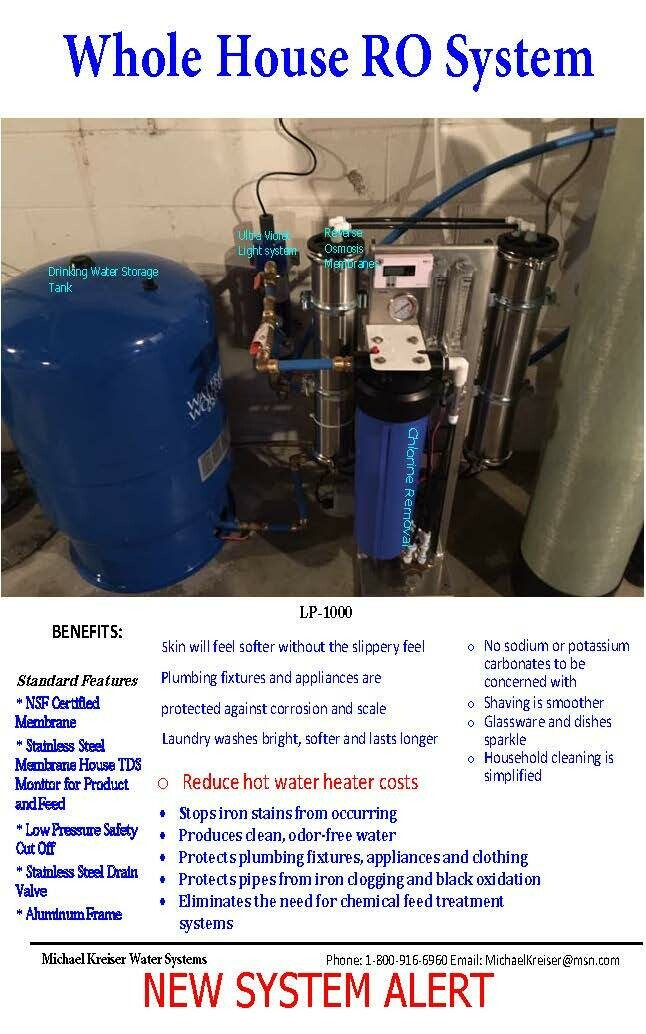Whole House Reverse Osmosis Water System (removes bacteria & Viruses) Financing Available
A semi permeable membrane, like the membrane of a cell wall or a bladder, is selective about what it allows to pass through, and what it prevents from passing. These membranes in general pass water very easily because of its small molecular size; but also prevent many other contaminants from passing by trapping them. Water will typically be present on both sides of the membrane, with each side having a different concentration of dissolved minerals. Since the water I the less concentrated solution seeks to dilute the more concentrated solution, water will pass through the membrane from the lower concentration side to the greater concentration side. Eventually, osmotic pressure (seen in the diagram below as the pressure created by the difference in water levels) will counter the diffusion process exactly, and an equilibrium will form.
The process of reverse osmosis forces water with a greater concentration of contaminants (the source water) into a tank containing water with an extremely low concentration of contaminants (the processed water). High water pressure on the source side is used to “reverse” the natural osmotic process, with the semi-permeable membrane still permitting the passage of water while rejecting most of the other contaminants. The specific process through which this occurs is called ion exclusion, in which a concentration of ions at the membrane surface from a barrier that allows other water molecules to pass through while excluding other substances.
Semi permeable membranes have come a long way from the natural pig bladders used in the earlier osmosis experiments. Before the 1960’s, these membranes were too inefficient, expensive, and unreliable for practical applications outside the laboratory. Modern advances in synthetic materials have generally solved these problems, allowing membranes to become highly efficient at rejecting contaminants, and making them tough enough to withstand the greater pressures necessary for efficient operation.
Even with these advances, the “reject” water on the source side of a Reverse Osmosis (RO) system must be periodically flushed in order to keep it from becoming so concentrated that it forms a scale on the membrane itself. RO systems also typically require a carbon pre filter for the reduction of chlorine, which can damage an RO membrane; and a sediment pre filter is always required to ensure that fine suspended materials in the source water do not permanently clog the membrane. Hardness reduction, either through the use of water softening for residential units or chemical softening for industrial use, may also be desirable in hard water areas.
Reverse osmosis can treat for a wide variety of health and aesthetic contaminants. Effectively designed, RO equipment can treat for a wide variety of aesthetic contaminants that cause unpleasant taste, color, and odor problems like a salty or soda taste caused by chlorides or sulfates.
RO can also be effective for treating health contaminants like arsenic, asbestos, atrazine (herbicides/pesticides). fluoride, lead, mercury, nitrate, and radium. When using appropriate carbon pre filtering (commonly included with most RO systems), additional treatment can also be provided for such “volatile” contaminants as benzene, trichloroethylene, trihalomethanes, and radon. Some RO equipment is also capable of treating for biological contaminants like Cryptosporidium. The Water Quality Association (WQA) cautions, however, that while RO membranes typically remove virtually all known microorganisms and most other health contaminants, design considerations may prevent a unit from offering foolproof protection when incorporated into a consumer drinking water system.
When looking for a product to treat for a given health contaminant, care should be used to find products that have been tested successfully for such purposes at a quality testing laboratory.









